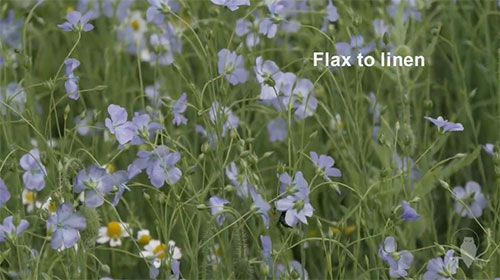My all-time favorite fabric for hand embroidery is linen. I love good linen, so I’m always at pains to seek it out and acquire it, not just for personal stitching but also for the kits and supplies that I offer here on Needle ‘n Thread.
Linen for hand embroidery is fairly widely available these days, if you really go to the effort to look for it. But quantity is one thing – quality is another. We have that “embarrassment of riches,” but it still takes effort to find the Good Stuff.
Luckily, there are people out there who care about getting really good linen into the hands of stitchers. There are companies that still make beautiful linen (predominantly in Europe), there are distributors who go to the effort and expense to bring it into the country so that shop owners have access to it, and there are shop owners who understand that there are stitchers who want good linen and they go to the effort and expense to stock it. And all this investment in money and effort keeps awareness up and it keeps the supply line going for now. And that’s a good thing!
But have you ever thought about how linen comes to be?

Kind of like the whole farm-to-table movement has raised awareness of where we actually get our food and how much effort it takes for quality food to be produced, this Flax to Linen video will show you how linen comes about and what it takes to get that piece of fabric into your hands.
Granted, the process is not done by hand these days. Still, it takes a lot of work to produce lovely fabric!
It’s a great video – super interesting to watch, mesmerizing, and relaxing! It’s just over 20 minutes long, so grab a cup, kick back, and enjoy!
There’s so much to be said for why linen is such a beautiful ground fabric for hand embroidery, but I have already said a lot about it here on the website. I won’t bore you by repetition! But you’re welcome to explore articles and projects on Needle ‘n Thread that involve linen or talk about linen.
I hope you enjoy this as much as I did! Have a fabulous weekend!







hola me mucho gusto todo lo que comparte me brinda alegria ver su pagina le mando un fuerte abrazo desde mexico soy su admiradora
J’ai beaucoup apprécié la video sur la confection du lin. Merci beaucoup….
Greetings!
When Hedgehog Handiworks left us a few years ago, I purchased a smallish selection of linens for embroidery, and I love them. I have tried the Alba Maxima, the Alabaster Angel, and Ecclesiastical linen, and they are all wonderful. But now that Hedgehog is gone, where can I purchase more?
Where do you purchase your high quality linen for embroidery from? Is there an online store that you would recommend?
Thank you very much for your advice.
Michele
Hi, Michele – Thanks for your note! Any locally owned needlework shop that carries goods from Access Commodities can special order the same types of linens that Hedgehog carried. I also sell linen. Right now, it’s available as sample packs, but for some customers looking for larger pieces, I’m happy to accommodate. Alba Maxima, Alabaster Angel, and the Ecclesiastical that Jody carried are no longer available. There are excellent substitutes available, though. That’s what my linen sampler packs are all about – giving folks the opportunity to try out different types or colors of very good linen that are available today.
So much work in a traditional way. It is exhausting just to watch all the steps involved and the rigorous way to do them, to produce a little piece of thread or fabric! You cannot survive producing linen that way for sure!
But very interesting indeed!
Thank you so much for sending the Rob Stephens flax video. It is a joy to watch him go from seed to weaving: such masterful work!
Mary, thank you so much for sharing this video. I was literally mesmerized. When I grow up, I want to be a flax-grower/linen-maker! I even downloaded the video, so I can watch it whenever I feel the need. It will be my new form of therapy.
I hope your eye is better. You’ve been in my prayers alot. I’ve told the Lord you need a break!
Fantastic video Mary. Thank you for sharing. I had no idea how labor intensive it was to go from planting to spinning then weaving. Certainly makes me appreciate those who know the craft and practice it today.
The Flax to Linen video was one of the most interesting and informative videos I have ever seen. Even though I realize that linen is now processed in a more modern, mechanized way – maybe even computerized – the number of steps it takes to go from flax seed to a workable piece of cloth must be pretty similar. No wonder linen of high quality is also pricey! Thank you so much for posting this – I’ve watched it twice!
We have a little flax farm here in our area that is (apparently) the only place growing flax for fiber use in the US. Everybody else grows a short variety for seeds. This year’s crop will be ready for harvest in the next couple of weeks, and they turn it into a lovely yarn and cloth. Maybe someday I’ll be able to stitch something on our very own local fabric, who knows?
Oooooh, nice!! That would be great to see in person! I’d love to watch their process. I’d also love to see the crop in bloom. Flax is very pretty.